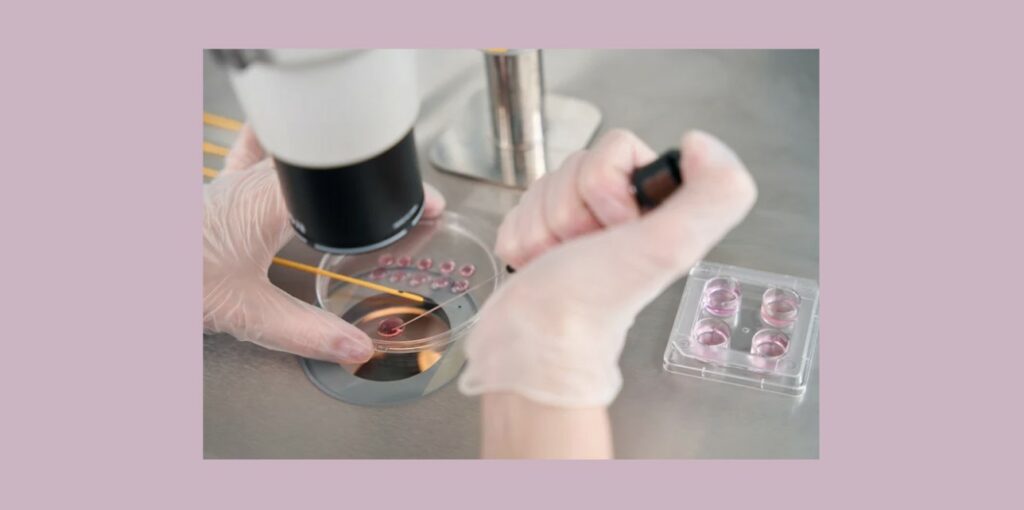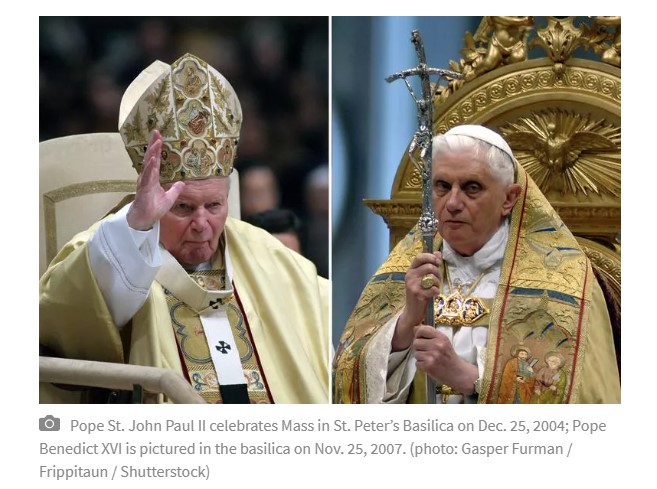
Italy’s Embryo Protection Law at 20: A Legacy of John II and Benedict XVI
By: Elizabeth Bothamley Rex, originally published October 22, 2025, The Catholic Register
COMMENTARY: Italy’s ‘Medically Assisted Reproduction Law’ remains the model legislation for the legal protection of children conceived through artificial reproductive technology.
Assisted Reproduction Technology milestones have been creating surreal headlines around the world.
On July 16, one headline in the MIT Technology Review read, “Researchers announce babies born from a trial of three-person IVF.” Another headline in the same publication just two weeks later on July 29, read, “Exclusive: A record-breaking baby has been born from an embryo that’s over 30 years old.”
“Three-Parent IVF” — also called “Mitochondrial Replacement Therapy” or MRT — is a treatment for infertility that uses and destroys donor embryos in order to provide healthy mitochondrial DNA taken from a donor embryo that is sacrificed to help “cure” an infertile couple’s own IVF-conceived embryo.
Three-Parent IVF involves creating an embryo with DNA taken from three parents: two women and one man. MRT is an artificial infertility treatment that was condemned by the Congregation for the Doctrine of the Faith in its 2008 Instruction Dignitas Personae:
The proposal that these [frozen] embryos could be put at the disposal of infertile couples as a treatment for infertility is not ethically acceptable for the same reasons which make heterologous procreation illicit (18).
There is no consensus among moral theologians regarding “prenatal adoption.” However, Dignitas Personae says, “This proposal, praiseworthy with regard to the intention of respecting and defending human life, presents however various problems … of a medical, psychological and legal nature.”
Clearly, the entire world is struggling with the urgent need to regulate the IVF industry in order to protect the highly vulnerable lives of children conceived in vitro with strict “embryo protection” laws. Germany passed its well-known “Embryo Protection Law” in 1990, and Italy passed its less well known “Medically Assisted Reproduction Law” in 2004. This essay will discuss Italy’s excellent embryo protection law that was inspired, promoted and defended by two popes: Pope John Paul II and Pope Benedict XVI.
In February 2024, Italy marked the 20th anniversary of one of its most important and controversial laws: Legge 40/2004, also known as Italy’s “Medically Assisted Reproduction Law (MARL).” Passed after years of debate, Italy’s regulatory legislation sought to balance compassion for married couples struggling with infertility with an equal commitment to protect the dignity and the lives of children conceived through in vitro fertilization (IVF).
At a time when most countries — including the United States — were expanding access to artificial reproduction with few or no ethical limits, Italy chose a different path: to pass a law that defends the right to life of human embryos brought into existence with the medical assistance of IVF from the first moment of their conception.

Pope John Paul II: ‘In the Interests of Children’
The inspiration for MARL came directly from the late Pope John Paul II, who had long urged lawmakers to defend life wherever it is threatened — including in the field of assisted reproductive technology (ART).
On May 23, 2003, just months before the law was passed, John Paul II addressed the Italian Pro-Life Movement:
Recurrent threats put unborn life at peril. The praiseworthy desire to have a child sometimes exceeds acceptable limits. Embryos produced in excessive numbers, selected and frozen, are submitted to destructive experimentation and destined to die in line with a premeditated decision. … I express the hope that the legislative process under way will quickly reach a conclusion and that it will go by the principle that whenever a decision is to be made between the desires of adults and the rights of children, it will be made in the interests of children.
The law that was passed in February 2004 reflected exactly that guiding principle: “the interests of children.”
What the Law Established
Italy’s new Medically Assisted Reproduction Law established strict boundaries for the practice of IVF. It allowed infertile married couples or those in a stable relationship to access treatment, but only after medical confirmation of infertility. Key provisions included:
A maximum of three embryos could be fertilized and all had to be transferred to the mother’s womb.
- No preimplantation genetic testing (PGT) or “selection” of embryos was permitted.
- Embryo freezing was prohibited, except in temporary emergencies.
- No donor sperm, donor eggs, or any form of surrogacy could be used.
- Informed written consent – prior to the fertilization process — required that all the embryos created would be maternally received as children, not discarded or frozen as “spares.”
At its core, MARL recognized that every child — even a child conceived in vitro — is not a possession to be engineered, selected, or discarded, but a person with the same dignity as every other member of the human family.
Pope Benedict XVI, Italy’s Bishops, and the 2005 Referendum Battle
The law’s protections were immediately challenged. In June 2005, just one year after its passage, Italy held a national referendum aimed at overturning MARL’s safeguards. Supporters of the referendum sought to loosen restrictions on embryo freezing, genetic testing, and third-party gamete donation.
However, in an extraordinary intervention, the Catholic Church in Italy mobilized to defend unborn life. Pope John Paul II had died only three months earlier in April 2005, but his successor, Pope Benedict XVI, along with the entire Italian Bishops’ Conference, threw their full support behind the law.
Rather than merely urging Catholics to vote “no,” the bishops employed a unique strategy: they urged Italians to abstain entirely from voting, knowing that if turnout fell below 50%, the referendum would be invalidated.
The New York Times captured the moment in a May 31, 2005, article titled “In Political Step, Pope Confronts Law on Fertility”:
Benedict raised the temperature a decisive degree by backing the strategy of Italian bishops, who have encouraged Italians to shun the referendum … ‘You are committed to illuminate the choice of Catholics and of all citizens in the imminent referendum on assisted procreation,’ the Pope told Italian bishops at a conference at the Vatican.
From pulpits across Italy, bishops and priests echoed the same message: protecting the lives of IVF-conceived children was not optional: it was a moral imperative. Flyers, brochures, and pastoral letters reminded Catholics that abstaining from the referendum was a form of active witness to life.
The result was decisive. Turnout reached just 25%, far short of the required 50%. The referendum failed, and Italy’s embryo protections survived.
Judicial Setbacks
Over the years, Italy’s Constitutional Court has softened some of MARL’s original restrictions. In 2009, the three-embryo limit was struck down, opening the way for embryo freezing. In 2014, the ban on donor gametes was overturned. In 2015, preimplantation genetic testing was legalized in cases of hereditary disease.
However, in 2024, the Court approved two additional “embryo protective” regulations: “post-mortem embryo transfer,” allowing a widow to transfer her frozen embryos even after her husband’s death; as well as “ex-partner embryo transfer” allowing the mother to transfer her frozen embryos after separation or divorce. These rulings emphasized that once embryos exist, and even if they are frozen, the patients’ informed consent cannot be revoked.
A Prophetic Vision
Italy’s approach to Medically Assisted Reproduction stands in sharp contrast to countries like Spain, Belgium, or the United States, where embryo freezing, genetic screening, and surrogacy remain largely unregulated.
The prophetic wisdom of MARL lies in its insistence that science and medicine must serve life, not control it. As the original law declared:
The use of medically assisted procreation is allowed … in the manner prescribed by this law which guarantees the rights of all stakeholders, including the unborn.
In practice, this meant that IVF in Italy was never a matter of “consumer choice.” It was a carefully regulated act of medicine, subordinated to the higher good of protecting children, mothers, and families.
Twenty Years Later: What Is at Stake?
Two decades later, MARL still provokes debate. Critics say it limits “reproductive freedom.” Supporters say it embodies a truly human vision of medicine and law, one that keeps the weakest — embryos — at the center.
For the Catholic Church, there is no ambiguity. John Paul II’s teaching remains clear: the rights of children must take precedence over the desires of adults. Benedict XVI and Italy’s bishops carried that conviction into the referendum battle of 2005. The citizens of Italy listened to the truth and defended Italy’s embryo protection law.
Today, as assisted reproductive technologies are rapidly advancing, the Catholic Church continues to urgently remind us that not everything technically possible is ethically permissible, and that strict regulations must be passed to protect human embryos from the abuses of medically assisted reproduction.
Model ART Legislation for the United States and the World
As the world marks 20 years since Italy enacted its Medically Assisted Reproduction Law, Catholics can see in it a model of how faith and reason can work together to shape laws that protect the dignity of every human being.
In an era when so many nations continue to permit the freezing, eugenic testing, and destruction of embryos, Italy’s law continues to bear witness to a higher truth: human life must be defended, respected, and cared for at every age and stage of development, beginning at conception.
Dr. Elizabeth Rex is a bioethicist and an associate scholar at The Charlotte Lozier Institute. This commentary was adapted from an essay published July 25 by the Society of St. Sebastian in its online publication, Sebastian’s Point.
Image: The Catholic Register-Gasper Furman/Frippitaun/Shutterstock.
